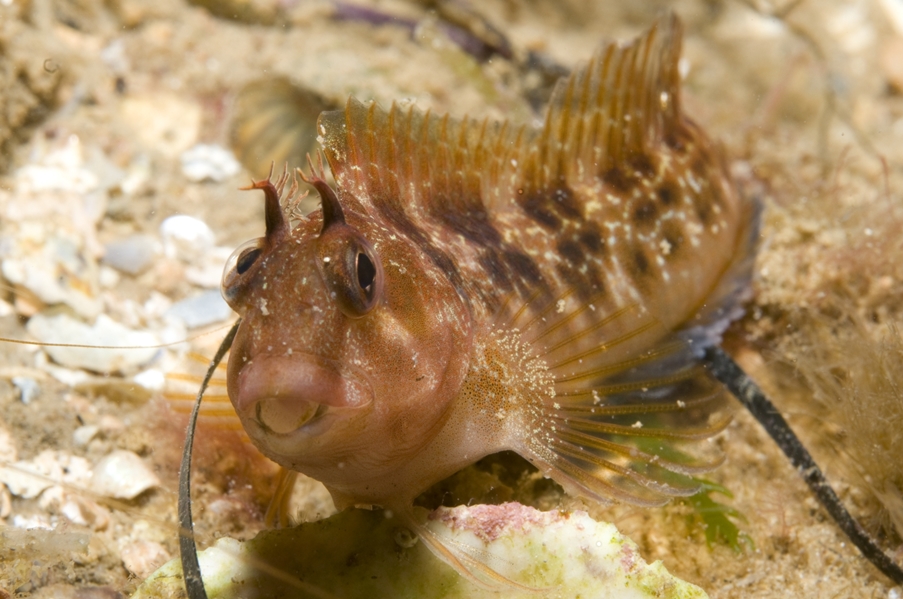- Classification
- ACTINOPTERYGII
- PERCIFORMES
- BLENNIIDAE
- Parablennius
- tasmanianus
Tasmanian Blenny, Parablennius tasmanianus (Richardson 1842)

A Tasmanian Blenny, Parablennius tasmanianus, in Port Phillip, Victoria. Source: Julian K. Finn / Museum Victoria. License: CC by Attribution
A common blenny with a large head, a blunt snout with a steep profile, and a large frilled tentacle over each eye.
Tasmanian Blennies are pale brownish to dark brown or bluish-grey with a pattern of irregular bars and blotches on the sides, and two dark bars radiating from below the eye. Males have about six indistinct darker saddle-like markings above the midline of the body. Females have indistinct saddles, each broken up into a checkerboard pattern.
This common blenny may be seen in tide pools and around jetties along the south coast. Individuals often poke their heads from holes and crevices, or even from discarded cans and bottles.
Tasmanian Blenny, Parablennius tasmanianus (Richardson 1842)
More Info
|
Distribution |
Endemic to southern Australia, from about Eden, New South Wales, to Ceduna, South Australia, in the middle of the Great Australian Bight, and around Tasmania. Inhabits shallow rocky reefs in sheltered bays and estuaries, in depths to 10 m. Tasmanian Blennies shelter under rocks in tidepools, in holes and crevices in shallow reefs, pylons, and often in empty cans and bottles. |
|
Features |
Dorsal fin XII, 16-19; Anal fin II, 19-20; Caudal fin 13; Pectoral fin 14; Pelvic fin I, 3. Head and body somewhat compressed, robust anteriorly, tapering towards tail; dorsal fin long-based; long fleshy fringed tentacles above each eye; large individuals may have a bulbous head. |
|
Size |
To 13 cm |
|
Colour |
Pale brownish to bluish-grey, covered in very fine spots or stipples. Males have about six indistinct darker saddle-like markings above the midline of the body. Females have indistinct saddles, each broken up into a checkerboard pattern. |
|
Feeding |
Herbivore, feeds on algae. |
|
Remarks |
Tasmanian blennies make excellent aquarium fish, and are always entertaining to watch. Prior to the description of Parablennius postoculomaculatus Bath & Hutchins 1986, the Tasmanian Blenny was thought to be widely distributed in Australian waters. |
|
Etymology |
The species is named tasmanianus in reference to the type locality, Port Arthur, Tasmania. |
|
Species Citation |
Blennius tasmanianus Richardson, 1842, Trans. Zool. Soc. Lond. 3(1): 129. Type locality: Port Arthur, Tasmania |
|
Author |
Bray, D.J. 2021 |
|
Resources |
Tasmanian Blenny, Parablennius tasmanianus (Richardson 1842)
References
Bath, H. 1989. Eine weitere Unterart von Parablennius tasmanianus (Richardson 1849) (Pisces: Blenniidae). Senckenbergiana Biologica 69(4/6): 293-300
Bath, H. 1996. Beitrag zur Osteologie der Arten der Tribus Parablenniini. Die Beziehungen der Knochen des Schädeldaches zum Seitenorgan-System und zu den Weichteilbildungen der Kopfoberseite sowie die systematische Bedeutung der Befunde nebst Bemerkungen. Senckenbergiana Biologica 76(1/2): 65-92
Bath, H. 2008. Review of the genus Parablennius Miranda-Ribeiro from Australia and New Caledonia (Pisces: Blenniidae: Salariinae). Stuttgarter Beiträge zur Naturkunde. Serie A (Biologie) Neue Serie 1: 77-94
Bath, H. & Hutchins, B. 1986. Die Blenniini des australischen Raums und Neuseelands mit Beschreibung einer neuen Art und einer neuen Unterart. Senckenbergiana Biologica 66(4/6): 167-213
Chamchang, C. 1997. The effect of biological and physical factors on the early life history and settlement of the Tasmanian blenny Parablennius tasmanianus tasmanianus in the Derwent estuary, Tasmania. PhD thesis, University of Tasmania. See ref online
Edgar, G.J. 2008. Australian Marine Life: the plants and animals of temperate waters. Sydney : Reed New Holland 2, 624 pp.
Fowler, H.W. 1908. A collection of fishes from Victoria, Australia. Proceedings of the Academy of Natural Sciences of Philadelphia 59(3): 419-444 figs 1-10 (described as Blennius victoriae) See ref at BHL
Gomon, M.F., Glover, C.J.M. & Kuiter, R.H (eds) 1994. The Fishes of Australia's South Coast. Adelaide : State Printer 992 pp. 810 figs.
Hutchins, J.B. & Swainston, R. 1986. Sea Fishes of Southern Australia. Complete field guide for anglers and divers. Perth : Swainston Publishing 180 pp.
Kuiter, R.H. 1993. Coastal Fishes of South-eastern Australia. Bathurst : Crawford House Press 437 pp.
Kuiter, R. & Kuiter, S. 2018. Coastal sea-fishes of south-eastern Australia. Seaford, Victoria : Aquatic Photographics, 371 pp.
Last, P.R., Scott, E.O.G. & Talbot, F.H. 1983. Fishes of Tasmania. Hobart : Tasmanian Fisheries Development Authority 563 pp. figs.
Richardson, J. 1839. Account of a collection of fishes from Port Arthur, Van Diemen's Land. Proceedings of the Zoological Society of London 7: 95-100 (as Blennius tasmanius, name only) See ref at BHL
Richardson, J. 1842. Descriptions of Australian fish. Part 1. Transactions of the Zoological Society of London 3(1): 69-131 figs 4-6 See ref at BHL
Smith-Vaniz, W.F. 2008. Family Blenniidae. pp. 693-696 in Gomon. M.F., Bray, D.J. & Kuiter, R.H (eds). Fishes of Australia's Southern Coast. Sydney : Reed New Holland 928 pp.
Williams, J.T. 2014. Parablennius tasmanianus. The IUCN Red List of Threatened Species 2014: e.T48342223A48393166. https://dx.doi.org/10.2305/IUCN.UK.2014-3.RLTS.T48342223A48393166.en. Downloaded on 16 December 2020.








